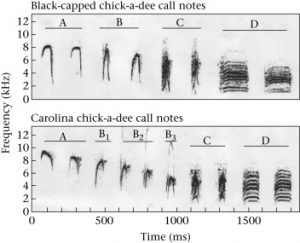What?
Teams of Vassar students and professors are investigating individual variation in the chickadee call in the population of Black-capped Chickadees at the Vassar Farm and Ecological Preserve.
Why?
Studying call variation amongst Chickadee individuals and populations can provide insight into animal communication with larger scale ecological and environmental implications.
How?
Using high tech recording equipment, our team of researchers records Chickadee vocalizations around the Vassar Farm. Their vocalizations in addition to their identifications are recorded and analyzed in the lab, allowing us to study call variation within the Chickadee population.
What do they sound like?
The chick-a-dee call consists of a combination of four notes: A, B, C and D. Each of the note types can be repeated multiple times within the same call, and frequency, note composition and syntax produce individual variation in calls.
Why do vocalizations matter?
Communication among chickadee flocks is vital to their survival. The chick-a-dee call is used in a variety of social contexts, such as predator warning and coordinating group movements. Studying Chickadee calls can tell us about not only chickadees but also songbirds, flock behavior, and broader animal communications and behavior.


